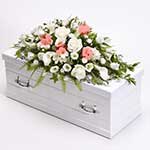The death of a baby in an early 20th century family UK

The death of babies and children was common in early 1900s England, but that made it no less harrowing. This page describes one such death as experienced by the older sister with additional comments on the emotions of the mother.
____
Extracted from the memoirs of the webmaster's mother (1906-2002) and edited by the webmaster with further research
The baby who died
My younger sister, Dorothy was 18 months old when she died. She was little more than a baby, but old enough to show her personality and be loved.
I was too young to remember much about her as I was only four years old, but I do remember when she died because it was so emotional.
The steam kettle treatment
Dorothy's cot was in my mother's bedroom and there was a canopy over it. There was also a steam kettle which looked like an ordinary kettle with a long spout. Although I didn't at the time know its function, I now know that it was to moisten the air to help a patient breathe. Dorothy had pneumonia which meant that it was difficult for her to breathe.
The linseed oil poultice treatment
Young as I was, what also struck me about the bedroom was the smell of the linseed poultice, which was a sort of gruel mixture, made very hot, then put between two layers of flannel, and placed onto patients' chests. To me, it wasn't an unpleasant smell and I can always recall it when my mind goes back into the past. It was supposed to help a patient breathe.
The doctor's diagnosis
My brother Ted was very ill at the same time. I can't recall any faces, only the bedroom and the doctor saying, "You'll lose that one, but that one may pull through". He could do nothing more than was already being done as there were no antibiotics - and he was seeing so much death that it must have been difficult for him.
The pre-death baptism
I recall that an aunt who lived in our road was in the bedroom with my mother and the parson. (That was what we called the minister.) He did something with water and I assume now that Dorothy was being baptised.
The funeral
I have a hazy recollection of a small white coffin and neighbours sitting in silence in our kitchen. Now I understand that coffins for babies and children were and are traditionally white.
I also have a vague picture of a neighbour from next door being in our kitchen, and I should think this was the day at the funeral, as it was common practice for someone else to be asked to look after the tea-making when the mourners came back to the house afterwards for the wake.
The unforgettable emotions
I suppose that the deaths of children was something that our parents lived with because it was so common, but it must have been very difficult for them. Much later my mother briefly gave way to her emotions and told me, "I can't bear to think of her (baby Dorothy) lying in that cold churchyard all alone".
My mother always said that Dorothy was the most loveable of her children. I don't think my mother meant to be unkind to the rest of us children. It was just that we never seemed to want to cuddle or be cuddled, whereas Dorothy did.
My mother kept a pair of white dolls shoes in her chest of drawers in memory of Dorothy. I understand that they had been taken off the doll that was buried with her, but my mother never spoke of them. Perhaps that was her way of coping.
| sources | webmaster | contact |
Text and images are copyright
If you can add anything to this page or provide a photo, please contact me.



